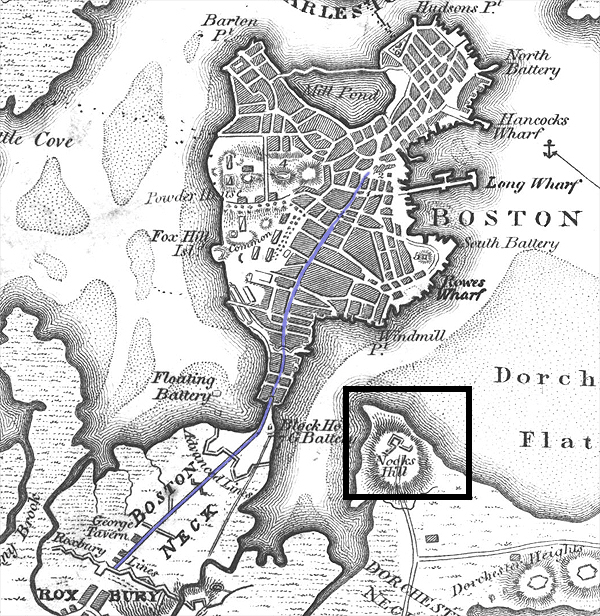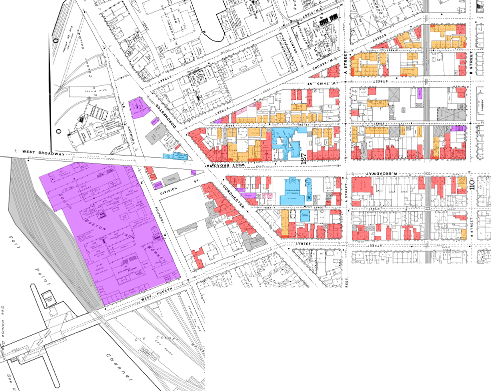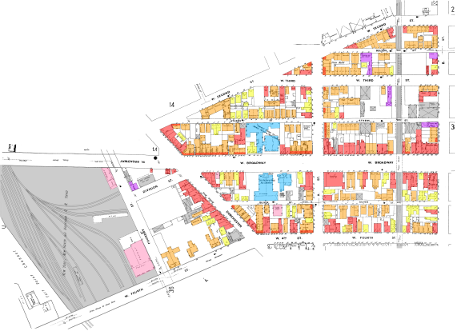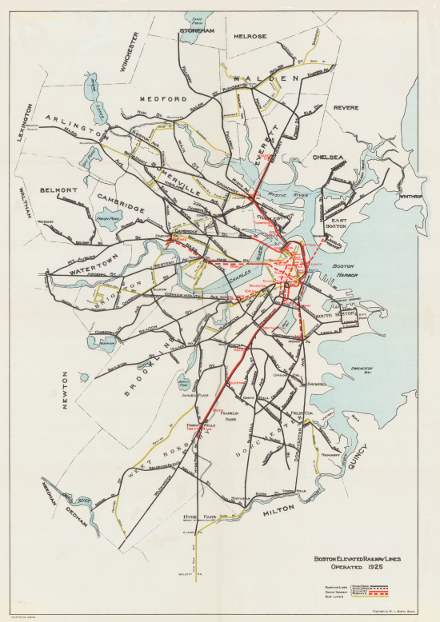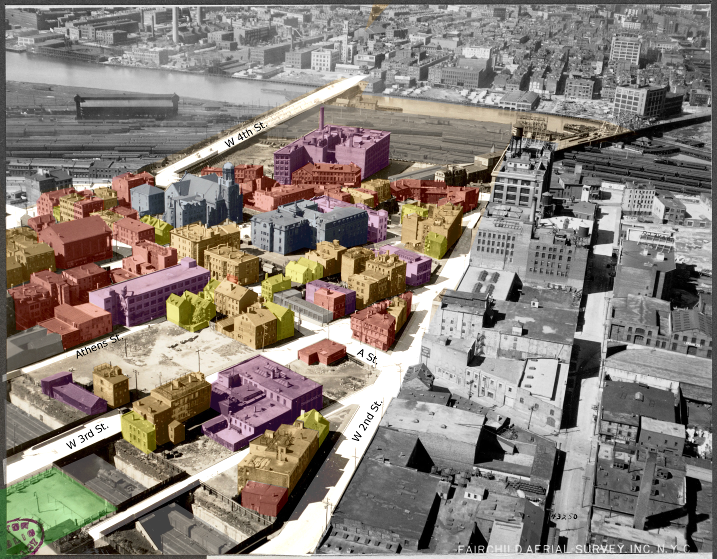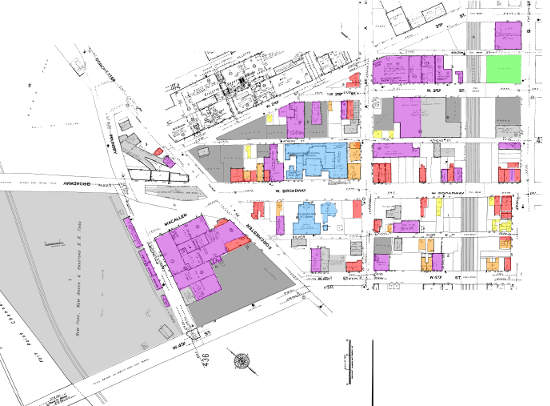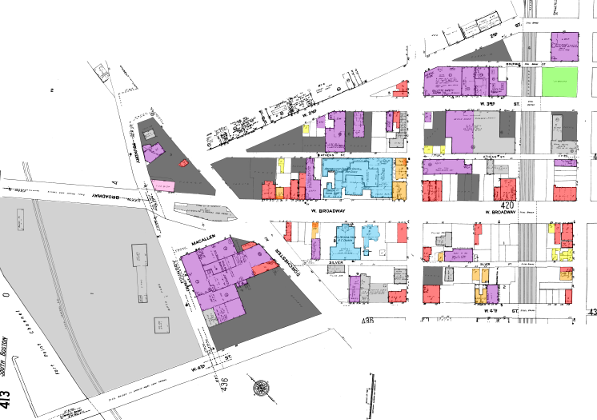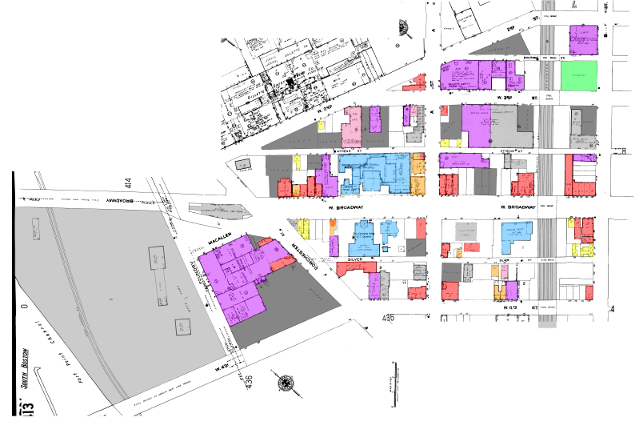Changes Over Time
West Broadway began as a lower-income immigrant residential neighborhood, then transformed into an industrial neighborhood, before once again becoming a residential neighborhood, but for high-income residents. The area was shaped by the developing industries of the surrounding area, as well as the changing transportation infrastructure of the Great Boston Area, which affected migration within the region. As noted in earlier papers, modern West Broadway is a collection of old buildings mixed with recent and new development. This can be tracked through time by observing historical documentation. Many of the older buildings within the site were built between the 1920s and the 1960s. Some of what has survived, especially industrial complexes, have been re-purposed or removed in order to provide housing. What once was an immigrant neighborhood is being gradually replaced with upper-class residents, mirroring similar development patterns in the the inner suburbs of Boston.
Early History
West Broadway is built mostly on natural land, save for the railyard east of Dorchester Avenue. This, combined with its short distance by water from the core of the city, meant that the site was developed early in the history of Boston. The earliest map found showing the former peninsula already shows development at the tip and a road leading down the Dorchester neck. By the 1860s, West Broadway's roads had been gridded and its pair of bridges had been constructed. Railway lines, specifically Old Colony and Boston, Hartford, and Erie R.R.s, were already running through the areA. The Catholic Church of Sts. Peter and Paul was constructed in the 1840s, and is the oldest building on the site surviving to the present day.
Late 19th Century – An Immigrant Neighborhood
At the end of the 19th century, West Broadway is primarily a residential neighborhood, despite the surrounding industry to the North and the massive rail infrastructure to the West. Boston Iron Works, the sole industrial complex within the site in the 1880s, was bought out by the railroad companies by 1898 and its campus converted into a railyard. It is interesting that despite the mass of rail infrastructure, West Broadway was not considerably industrialized until the mid-20th century. However, it can be explained by fact that, while much of the rail passed through West Broadway, none of it terminated within the area. The Old Colony Railroad (running along Fort Point Channel) terminated at South Station, and was thus probably primarily passenger conveyance, and the railroads running along B St. ran further north and terminated near the modern-day financial district. The fact that industry developed outwards from the railway hubs is consistent with the phenomena described by Jackson in Crabgrass Frontier.
The residential character of West Broadway shows its history; South Boston is historically considered a home to working-class immigrants, most notably Irish Catholics, and this is makeup of the neighborhood. The site is filled with housing, though it is nearly all made up of 3–6 story tenement houses, associated with working-class families as “any family of even modest social aspirations insisted on a private dwelling, however humble” (Jackson 90). In addition, the Sts. Peter and Paul Catholic Church and the associated women's school across the street were enduring features of the community from the mid 1800s up until the 2000s, reasonable given the overwhelming Catholic majority.
In the late 1800s, the main methods of transportation were horse and carriage and trolleys. Trolley lines ran from Boston proper along W. 4th St., Dorchester Ave., and Broadway. Horses, however, were obviously still influential; stables speckle the site, along with hackney and carriage companies. This will change as the subway is built in the early 20th century, and as the "horseless carriage" gains popularity in the 1920s.
Early 20th Century – Gradual Change
The first two decades of the 20th century brought industry into West Broadway. The first resident of the Foundry-Dorchester block, The Macallen Company, appeared and Division St. was renamed in its honor. The tenements of the neighborhood began disappearing, being either converted to commercial space or simply razed to the ground. The nature of transportation in the neighborhood also was in flux during the early 20th century. Many of the stables from earlier were destroyed or converted into industrial storehouses. By 1917, the Red Line had been extended to Broadway Station, creating an interface between the subway and the above-ground trolley system. The intersection of Broadway and Dorchester Ave. was altered to create an island housing a railway station shelter. The influence of the automobile is also starting to be seen in the 1925 aerial photograph of the neighborhood: there is a single garage complex on A St. and a few vehicles on Broadway near the church. A number of the building from this decade still survive in some form, contributing to the mixed character of the neighborhood in the present day.
Late 20th century – Industrial Takeover
The second half of the 20th century shows radical change from the earlier years. In previous decades, the neighborhood was composed of many, tiny lots and collections of small buildings. By the 1960s, large areas of West Broadway had consolidated into block-sized lots as industry continued to move into the the site. The other major shift is the takeover of the automobile. Large swaths of land once occupied by stores and residences became home to parking lots. Automobile-related infrastructure, including garages, filling stations, and repair shops appear across the site. A total of 4 filling stations and 5 automotive businesses are present in 1962 across the neighborhood. Housing has all but disappeared, and aside from the industrial landmarks, more space within the site is simply empty. This is possibly symptomatic of the general 20th century urban exodus, as transportation from the urban core to the outer suburbs became easier as rail transit and automobiles further developed. In addition, The West Broadway Housing Development (also known as the D Street Projects) was built in the 1940s just to the East of B St. This may have provided housing for the lower-income population who were vacated from West Broadway's tenements but could not afford to migrate further out into South Boston or Dorchester. Bass Warner confirms the trend, as he details a loss of 400,000 from the city proper between the years of 1950 and 1990 (Warner 11).
21st Century – Return to Residential
West Broadway then appeared to remain roughly static until the turn of the century, when the region's development changed direction. In the 2000s, West Broadway's industrial character declined, and many of the previous tenants vacated their buildings. Real Estate developers started building for high-income residents who wanted to return to the urban center. The catholic school was torn down in 2008 to build a new apartment complex. The Sts. Peter and Paul church was bought by developers and converted into apartments. Today, the neighborhood is once again primary residential, though it has converted from crowded tenement housing to luxury condominiums. The trend continues, as the four major developments underway are building still more high-rise condominiums. Interestingly, despite completely changing the nature of the area, a number of the current housing developments hint at previous times: The Macallen Building Condominiums, Court Square Press Condominiums, The Spice Lofts, and the restaurant Coppersmith all reference the previous tenants of their land. This development also follows the modern urban migration pattern, with the younger, upper- and middle-class generation returning to the cities that their parents vacated.
The people of the city provide the forces that shift its development. West Broadway has transformed from residential to industrial back to residential as the priorities of the inner city have changed and the desire of the population to inhabit urban environments has waxed and waned. Presently, it is again fashionable to live in the urban environment, and West Broadway is going through a housing boom, especially as mass transit has become more appealing in the era of congested highways and rush-hour traffic. However, it remains to be seen whether this trend will continue or if another wave of urban exodus will occur. The West Broadway of today is nearly unrecognizable from the early neighborhood, and it will probably be equally unrecognizable in the future.
Bibliography
1. Boston, Massachusetts [map]. "Sanborn Fire Insurance Maps" 1885–1888. Vol. 4, 1889. Plates 413, 414, 419, 420, 437. LINK
2. Boston, Massachusetts [map]. "Sanborn Fire Insurance Maps" 1895–1900. Vol. 4, 1899. Plates 413, 414, 419, 420, 437. LINK
3. Boston, Massachusetts [map]. "Sanborn Fire Insurance Maps" 1908–1938. Vol. 4, 1923. Plates 413, 414, 419, 420, 437. LINK
4. Boston, Massachusetts [map]. "Sanborn Fire Insurance Maps" 1962. Vol. 4. Plates 413, 414, 419, 420, 437.
5. Boston, Massachusetts [map]. "Sanborn Fire Insurance Maps" 1981. Vol. 4. Plates 413, 414, 419, 420, 437.
6. Boston, Massachusetts [map]. "Sanborn Fire Insurance Maps" 1992. Vol. 4. Plates 413, 414, 419, 420, 437.
7. "The Boston Neck." LINK
8. Fairchild Aerial Survey, Inc. "South Boston with Dover St. Bridge and Broadway Bridge." 1925. Gelatin Silver Photographic Print. Digitized. Colored. LINK
9. Jackson, Kenneth T. "Crabgrass Frontier: The Suburbanization of the United States" (New York: Oxford University Press, 1985).
10. Van Voorhis, Scott. "Developers Nix Condos, Build Rentals in Southie." The Boston Herald. Online. May 21, 2008. Accessed April 21 2018. LINK
11. Warner, Sam Bass. "Mapping Boston, A Brief History of Boston." (Cambridge MA: MIT Press, 1999).
12. "West Broadway, Boston, MA." Map. Google Maps. Google, 2018. Web. Traced and Colored.
13. "1885 West End Street Railway Map." 1885 Digitized. LINK
14. "1925 Boston Elevated Railway Map." 1925. Digitized. LINK
